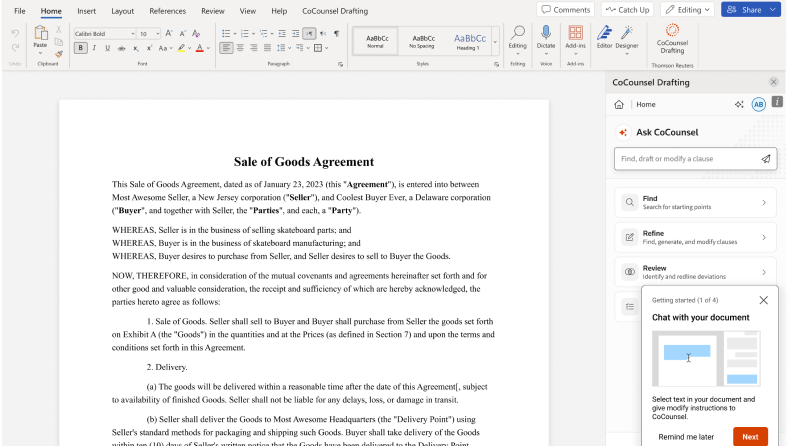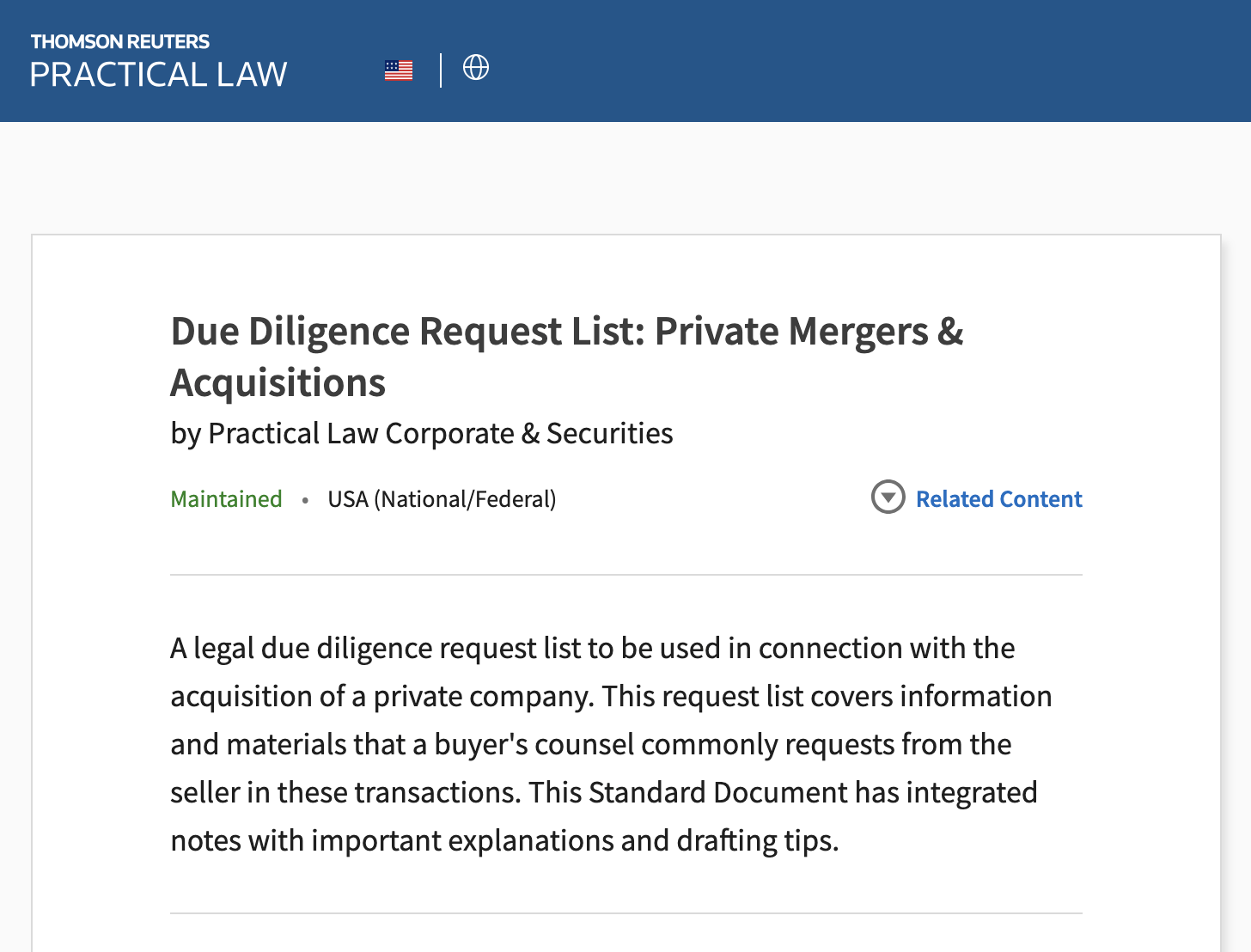Definition, common examples in various sectors, and how-to conduct due diligence
← Legal terms • diligence • due diligence
Highlights:
|
Jump to ↓
| What is due diligence? |
| Types of due diligence |
Examples of due diligence in different sectors
| How to conduct due diligence |
Due diligence templates and research resources

CoCounsel Legal
More than double your speed on document review and contract drafting, letting you focus on higher-value work
Try AI for due diligence ↗Definition and overview
Due diligence is the investigation of a person or business. In the context of mergers and acquisitions, the parties use the due diligence process to gather information about each other and about the business or assets that are for sale. Although due diligence on the buyer is particularly important to the seller in certain situations, the due diligence process is usually more significant for the buyer.
|
Black’s Law Dictionary
12th ed. 2024
For attorneys, due diligence is one of the most crucial tasks to perform for a client planning a purchase or merger. Diligence teams ensure that undertaking a deal won’t backfire and damage their client’s operations. To do so, the diligence team must establish a seller’s risk profile by examining its past actions, its present situation, and its future ambitions.
Challenges and types of due diligence
The most noted challenge in the early stages of a due diligence process is often not knowing what questions to ask. This stems from several factors such as lack of initial information,
complex nature of the process, and tight time constraints.
Then there are various types of due diligence which fall into two general categories: “hard” due diligence and “soft” due diligence, though there are plenty of overlaps between the two.
Hard due diligence
Hard due diligence is a study of the facts about a potential purchase: analyzing numbers and data. It means delving into financial records, financial statements, contracts, licensing agreements, litigation proceedings. Further, it’s about determining a seller’s tax exposures and liabilities and assessing if the target complies with various regulations and laws.
Areas of diligence here include:
- Operational due diligence
- Tax due diligence
- Legal due diligence
- IP due diligence
Soft due diligence
Soft due diligence investigates a seller’s corporate culture. Diligence teams analyze how the seller’s business works, from its managers to its employees to its customers and clients, and how much of an integration challenge these could pose.
Areas of diligence here include:
- Commercial due diligence
- Human resources due diligence
- Environmental due diligence
Conducting diligence means acquiring in-depth knowledge of the seller, across a wide variety of areas and in different contexts.
For example, there’s the corporate finance context:
- If the buyer is acquiring a company, is this company financially sound?
- If it entails a real estate purchase, has the current owner correctly valued the property
- Does it have any outstanding claims on it, like government liens?
Then there’s the operational context:
- How does the potential acquisition function?
- Are there flaws in its business model—serious enough for the buyer to consider pulling out of the deal?
The diligence team should give the buyer everything that it needs for well-informed strategic decision-making.
Examples of due diligence in various sectors
| Context | Objective |
|---|---|
| M&A legal due diligence Diligence teams have to process a massive amount of data while typically under a strict deadline to complete analyses and present their findings to the buyer | Make sure the buyer knows about current and potential legal issues before they make an acquisition |
| Tax and accounting Lawyers go through the target’s filings to determine current tax exposures | Ensure that the buyer won’t inherit any tax-related headaches |
| Finance Teams dig through a company’s financials looking for red flags such as accounting practices not in compliance with industry standards | Get an accurate assessment of the target’s financial condition for the buyer to compare with the seller’s claims as to its financial health |
| Operations “Lift the hood” on a company to see how it runs and uncover major operational risks | Assess the company’s operational fitness so that the buyer knows what integration challenges the target could present |
| Intellectual property IP is often central to the valuation, particularly if the company is competing in an innovative sector where players rise and fall based upon the depth of their IP and how they exploit it | List what the company’s IP holdings are and verify that ownership and usage is secured |
| Commercial The condition of the target’s business and marketing strategies | Determine whether the company’s business model is a strategic fit for the acquirer and will help the acquirer achieve long-term aims |
| Human resources What is the company’s employee base and management structure? | Ensure that the seller’s workforce is compatible with the buyer’s and will present no unexpected employee integration challenges |
| Real estate A company’s real estate holdings can be a hurdle in deal negotiations | Verify that the seller’s real estate holdings and obligations won’t present unexpected and potentially costly problems to the acquirer |
| Environmental Environmental site assessment (ESA) and environmental, social, and governance (ESG) standards | Break down the company’s environmental policies, ensure they’re in compliance with relevant regulations, and make sure that its ESG policies align with the acquirer’s |
| Regulatory Ideally, company should not have any outstanding issues with federal, state or local regulators | Make sure that the selling company has a verifiable, well-maintained set of conduct standards, and that none of its employees are in violation of them |
| Investigative, risk, and fraud More specialized form of due diligence which requires in-depth investigations and intelligence gathering | Identify the compliance culture and the corruption risk in the specific target. |
M&A (Mergers and acquisitions) due diligence
Due diligence can make or break a merger or acquisition. Conducting diligence is how the prospective buyer gathers evidence to determine whether the seller is financially sound, to see if it’s a good cultural and technological fit for its existing operations, and what issues could delay or end the deal.
In M&A, diligence teams have to process a massive amount of data while typically under a strict deadline to complete analyses and present their findings to the buyer. It’s why more firms are using next-generation solutions which incorporate generative artificial intelligence (GenAI).
Properly trained AI can automate document identification and extract essential clauses, thus increasing the speed and accuracy of diligence analyses and enabling lawyers to concentrate their efforts on issues that require specific sector or legal expertise.
In legal due diligence, lawyers examine how the target’s operations have been affected by legal issues, and what, if anything, could present a potential legal challenge in the future.
Legal issues may include:
- Issues related to the legal status of intellectual property licenses, non-compete clauses in employee contracts, franchise agreements, vendor contracts, etc.
- How the target stands with federal and state regulators — for example, if it’s currently in negotiations with regulators to get into compliance.
- Status of ongoing or upcoming litigation: what the issues are, what the likelihood of the target prevailing in the case is.
- Outstanding liabilities that could impair a business transaction from closing.
For instance, legal opinions typically set out the scope of the due diligence that the opinion giver has undertaken in order to deliver the opinion. The due diligence checklist below describes in detail searches conducted and information gathered in connection with a legal opinion in a financing transaction. It also discusses the issues counsel should consider in connection with opinion due diligence.

CoCounsel
Bringing together generative AI, trusted content, and expert insights
Meet your AI assistant ↗Tax due diligence
If a target company has tax problems, that could spell trouble for an acquisition. In tax diligence, lawyers go through the target’s filings to determine current tax exposures and note if anything could change about the seller’s tax obligations in the near-term.
Diligence teams document the company’s tax structure, ensure that all of the company’s taxes have been adequately documented and paid, and examine past audits and any agreements that were made with tax agencies.
Equally important is to get a sense of what the tax obligations of a post-merger company will be. By acquiring the target, does the buyer enter a new tax jurisdiction, whether it’s a state or country? Will integrating the target’s operations into the buyer’s expose the latter to new, unexpected tax obligations?
Financial due diligence
In conducting financial due diligence, diligence teams dig through a company’s financials. They’re looking for red flags, which can include:
- Accounting practices not in compliance with industry standards
- Notable disruptions, past or present, to cashflows
- Contentious asset ownership issues
- Current debt levels, including interest rates and terms noting whether and how much debt is coming due in the short-term
- Non-compliance of know your customer and anti-money laundering regulations for banks and other financial institutions
Other areas may include a company’s profit margins — particularly if they’ve been eroding due to competition or greater levels of expenses — the company’s fixed and variable costs, and the controls that it uses to monitor and check spending.
Operational due diligence
In operational due diligence, diligence teams “lift the hood” on a company to see how it runs. If the company is a manufacturer, teams review its manufacturing and shipping process and note what physical investment, whether it’s equipment or real estate or transportation, this process requires. If the company is a software developer, teams look at how its design process works — its use of outsourcing, for instance.
Other things to assess include supply chain operations, who the company’s essential suppliers and distributors are, and how these compare in terms of cost and efficiency with competitors. The company’s information technology systems are examined to see if the target has next-generation or industry standard levels of tech, or if it will need to be severely upgraded once acquired.
What diligence teams want to uncover are any major operational risks — inefficiencies that will require a new owner to make a substantial investment to improve.
Intellectual property due diligence
A company’s intellectual property (IP) is often central to its valuation, particularly if the company is competing in an innovative sector like technology or pharmaceuticals, where players rise and fall based upon the depth of their IP and how they exploit it.
- In IP due diligence, diligence teams examine a company’s IP assets, which could include:
- Patents for technologies, products, processes, etc.
- Copyrights for creative assets such as software, films, artwork etc.
- Trademarks for products
- Trade secrets
The team makes a full inventory of these assets to determine whether ownership has been established, such as via chain-of-ownership documentation, or if are there any outside claims to ownership. Further, diligence teams check the company’s licenses to use third-party IP such as technology solutions to verify these are in order. They note any potential integration challenges, such as the buyer needing to renegotiate IP usages upon acquiring the company.
Commercial due diligence
In commercial due diligence, teams assess the condition of the target’s business and marketing strategies. Teams evaluate where the company stands when compared with its competitors, taking into account product ranges and market shares. The team also examines the target’s growth prospects and stated future plans for expansion.
- Other essential information to review includes:
- Customer base demographics and churn rate
- Annual sales and marketing budget and how the company deploys its spending
- Product pricing, margins, and diversity of offerings
Human resources due diligence
HR diligence assesses the company’s employee base and management structure and notes any potential conflicts that these may present.
Take compensation, for example.
- How, and on what schedule, are employees compensated?
- What is the company’s bonus structure and what benefits are offered?
- What is the vacation and sick leave policy?
If there’s a substantial divide between acquirer and target on any of these fronts, that could impact post-merger integration. For example, if target employees will see a sharp reduction in medical benefits.
Diligence teams also verify that the seller is complying with all applicable local, state, and federal labor laws, and where things stand with union relations. Policies on discrimination, harassment, or wrongful termination are examined, as are nondisclosure and non-compete agreements in employee contracts.

Practical Law Standard Document
Due Diligence Request List: Private Mergers & Acquisitions
Access with free trial ↗Real estate due diligence
A company’s real estate holdings can be a hurdle in deal negotiations. For instance, if a target company has a physical location whose conditions are violating local codes or zoning laws, the acquirer may need to quickly get the property in compliance.
The timeframe to perform due diligence is known as the due diligence period. The due diligence period is a negotiated, fixed amount of time, which varies from deal to deal.
If a business is a landlord, and leases properties for the use of other businesses, a diligence team may assess these facilities’ occupancy rates, verify all paperwork related to the properties that a company owns or administers, and make sure that all operational expenditures are declared in its financials.
- Other issues include:
- Current leases like terms, conditions, duration
Real estate taxes. For example, current obligations and potential of tax increases in the short-term
Environmental due diligence
A target company’s environmental profile could be a plus or serious negative for an acquirer. For instance, while doing real estate diligence, teams may also do an environmental site assessment (ESA) of the conditions of its properties to determine if there are any environmental liabilities and what the company’s record is in terms of past violations and fines.
There’s also the question of whether the company complies with applicable environmental, social, and governance (ESG) standards. If the acquiring company adheres to a set of ESG industry standards, purchasing a company that’s in violation of these could be a serious impediment to the deal.
Regulatory due diligence
Any company being acquired should ideally not have any outstanding issues with federal, state or local regulators. It’s particularly important for sectors with substantial professional ethics requirements for employees — such as legal, financial, and healthcare companies.
In regulatory diligence, teams will review such information as:
- The company’s standards of conduct for employees, suppliers, contractors, etc.
- Company’s training efforts as to its conduct standards
- How the company monitors and investigates conduct violations
- Penalties for conduct violations
Investigative, or risk and fraud due diligence
There may be a need to conduct a more specialized form of enhanced due diligence (EDD) which requires in-depth investigations and intelligence gathering. For example, if the company in question, or if individuals at this company, are involved in any sort of fraud investigation.
This type of diligence typically requires online investigative software that scans a variety of databases, conducts background checks, including court and criminal records, to fill in the picture about a particular employee’s past, for example.

2025 Future of Professionals Report
Survey of 2,275 professionals and C-level corporate executives from over 50 countries
View report ↗How to conduct due diligence
Organizing and conducting the due diligence process for an M&A deal requires much preparation and coordination. Once a deal gets underway, the buyer and its law firm typically follow this strategy:
- Define due diligence tasks. Note which areas are likely to present potential risks to the acquirer, and which could take the most time to review.
- Assemble the due diligence team. Be sure to have relevant experts if, for example, diligence will require substantial work assessing the seller’s taxes, real estate, IP, or other areas.
- Submit diligence requests and get access to information
- Conduct diligence
- Summarize findings and distribute materials to all relevant parties
When reviewing materials, diligence teams are looking for documents that could negatively impact the transaction. As seen above, this could range from an unexpected debt obligation coming due in the short term, to intellectual property that does not have a clear chain of ownership, to a manager or employee who’s in violation of professional ethics.
Due diligence templates and research resources for lawyers
Due diligence means analyzing a vast array of information, quickly determining what the trouble spots are, and presenting your findings in an easy-to-comprehend manner to your client.
By using innovative due diligence solutions, lawyers make this challenging task both more comprehensive and more intuitive — delivering accurate results faster than ever before. The stakes are usually high in M&A, and time is always of the essence. The diligence team that can best handle these pressures will improve their standing with clients and will likely win new ones.
Templates
The Practical Law Standard Documents below provide you with:
- A legal due diligence request list to be used in connection with the acquisition of a private company
- A due diligence summary template to be used when reviewing and summarizing a target company’s commercial agreements as part of the due diligence review for a potential merger or acquisition deal
- A due diligence summary template to be used when reviewing and summarizing past stock purchase, asset purchase, or merger agreements of the target company as part of the buyer’s due diligence review in a potential merger or acquisition by the buyer of the target company.
- A due diligence summary template to be used when reviewing and summarizing a target company’s organizational documents as part of the due diligence review for a potential merger or acquisition deal.

AI news and insights
Industry-leading insights, updates, and all things AI in the legal profession
Join community ↗






